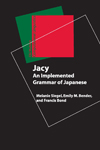

|
|
|
|

Jacy: An Implemented Grammar of JapaneseThis book describes the fundamentals of Jacy, an implementation of a Japanese head-driven phrase structure grammar (HPSG) with many useful linguistic implications. Jacy presents sound information about the Japanese language (syntax, semantics, and pragmatics) based on implementation and tested on large quantities of data. As the grammar development was done in a multilingual environment, Jacy also showcases both multilingual concepts and differences among the languages and demonstrates the usefulness of semantic analysis in language technology applications. is professor of information science at Darmstadt University of Applied Sciences, Germany. is professor in the Department of Linguistics, adjunct professor in the Department of Computer Science and Engineering, faculty director of the Master of Science in Computational Linguistics, and director of the Computational Linguistics Laboratory, all at the University of Washington. is associate professor in the Division of Linguistics and Multilingual Studies, Nanyang Technological University, Singapore. Contents
November 5, 2016 ISBN (Paperback): 9781684000180 (1684000181) |
Distributed by the
University of Chicago Press |
|
pubs @ csli.stanford.edu
|
CSLI Publications
Stanford University Cordura Hall 210 Panama Street Stanford, CA 94305-4101 (650) 723-1839 |